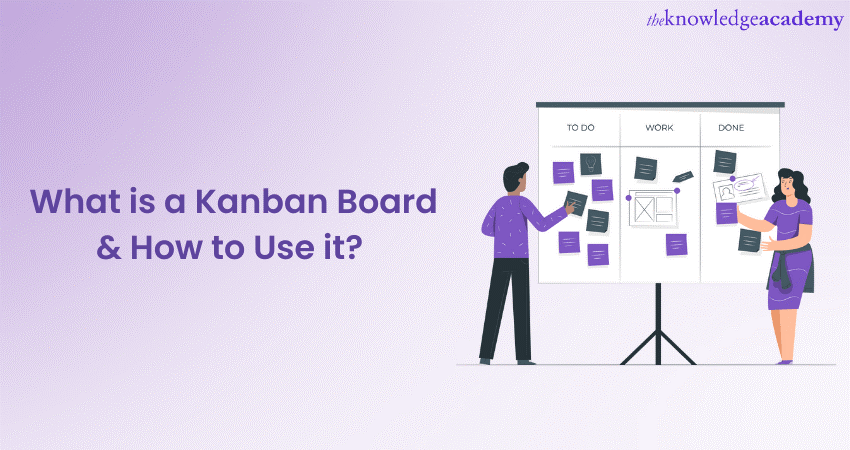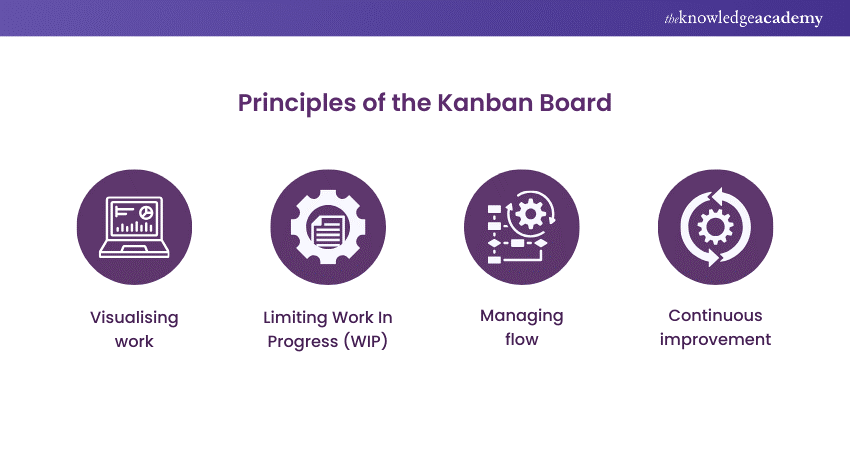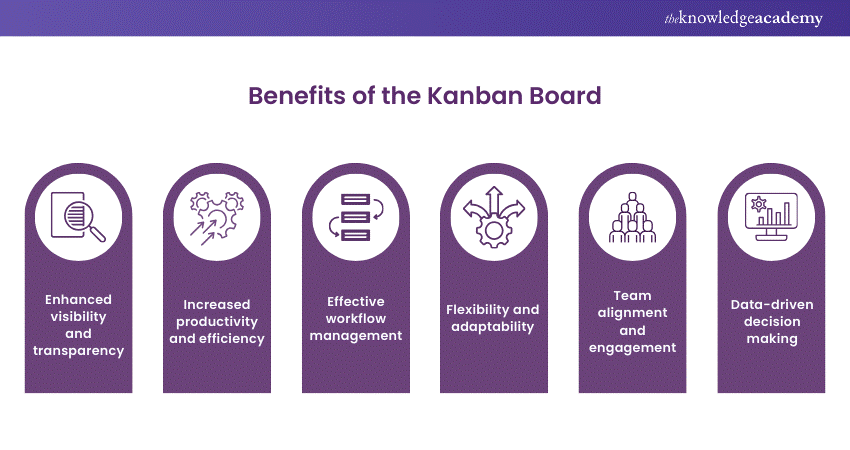We may not have the course you’re looking for. If you enquire or give us a call on 01344203999 and speak to our training experts, we may still be able to help with your training requirements.
Training Outcomes Within Your Budget!
We ensure quality, budget-alignment, and timely delivery by our expert instructors.

The world of Project Management has witnessed numerous methodologies and tools designed to enhance productivity and efficiency. One such tool is the Kanban Board, which has gained popularity in various industries.
According to the State of Kanban report of 2022, 87 per cent of organisational teams reported the Kanban Board as more effective than other methods. The same report revealed that 86 per cent of organisations wanted to expand their adoption of Kanban in the upcoming years. The Kanban Board is a visual tool used in Project Management and workflow management that provides a visual representation of work items & their progress within a project.
Table of Contents
1) What is Kanban Board?
2) What are the Kanban Board features and components?
3) Benefits of the Kanban Board
4) Implementing Kanban in your workflow
5) Conclusion
What is Kanban Board?
A Kanban Board is a visual management tool designed to enhance workflow efficiency and transparency in Project Management. Originating from Japanese manufacturing practices, it represents a dynamic way to visualise tasks and their progress. The board typically consists of columns representing different stages of a process, such as "To Do," "In Progress," and "Done."
Each task is represented by a card, allowing teams to see the work status at a glance. As tasks move through the stages, team members update the board accordingly. This simplicity fosters real-time collaboration, reduces bottlenecks, and enhances productivity. With its adaptability to various industries, the Kanban Board has become a popular agile methodology, promoting continuous improvement and streamlined project execution.
What are the Kanban Board features and components?
Kanban Boards employ key components to optimise workflow visualisations and management. Here is an overview of these components:
a) Kanban cards: Visual representations of tasks containing pertinent information like deadlines, assignees, and descriptions.
b) Kanban columns: Each column signifies a distinct workflow stage, guiding tasks from initiation to completion.
c) Work In Progress (WIP) limits: Imposed restrictions on task quantities in different workflow stages, enhancing focus on current tasks for expedited completion.
d) Kanban swimlanes: Horizontal lanes facilitating the segregation of activities, teams, or service classes.
e) Commitment point: Marks the stage where a work item is ready for integration into the system.
Understanding the Kanban method
The Kanban method is a visual Project Management approach that aims to optimise workflow, improve productivity, and enhance collaboration within a team or organisation. Originating from the Toyota Production System in the 1940s, Kanban has evolved into a widely adopted methodology across various industries. This system aimed to optimise workflow and minimise waste by implementing a pull-based production system.

Principles of the Kanban Board
The core principles of Kanban revolve around visualising work, limiting work in progress (WIP), managing flow, and fostering continuous improvement. Teams can streamline their processes, increase efficiency, and deliver value more effectively, by adhering to these principles:

a) Visualising work: At the heart of Kanban is the visualisation of work. This involves creating a visual representation, typically in the form of a Kanban Board, where tasks and their status are displayed. The board can be physical or digital, with columns representing different stages of the workflow. Each task is represented by a card or sticky note, allowing team members to have a clear overview of their work and progress.
b) Limiting Work In Progress (WIP): Kanban emphasises the importance of setting WIP limits for each stage of the workflow. By restricting the number of tasks that can be worked on simultaneously, teams can avoid overburdening individuals and prevent bottlenecks. WIP limits ensure a smooth flow of work, encourage better focus, and reduce the risk of multitasking, which can lead to inefficiencies and errors.
c) Managing flow: Managing flow involves optimising the movement of tasks through the workflow. By analysing the flow of work, teams can identify bottlenecks and areas of improvement. With a focus on continuous improvement, Kanban encourages the identification and resolution of obstacles that hinder the flow of work. This may involve reallocating resources, improving processes, or addressing systemic issues.
d) Continuous improvement: The Kanban method promotes a culture of continuous improvement. Teams are encouraged to reflect on their processes, seek feedback, and make incremental changes to enhance efficiency and effectiveness. Regular meetings, such as Kanban stand-ups or retrospectives, provide opportunities for teams to discuss challenges, exchange ideas, and implement improvements. This iterative approach fosters a culture of learning and adaptation, allowing teams to evolve and deliver better outcomes over time.
Adapt an appropriate Kanban initiative, by signing up for the Certified Kanban Foundation Course now!
Benefits of the Kanban Board
The benefits of the Kanban Board comprise the following:

1) Enhanced visibility and transparency
One of the key benefits of using a Kanban Board is the enhanced visibility and transparency it provides. By visualising tasks and their progress on the board, team members can have a clear understanding of the overall workflow. Everyone can easily see what tasks are in progress, what tasks are completed, and what tasks are still pending. This transparency fosters better communication and collaboration within the team, as everyone is on the same page regarding the status of work.
2) Increased productivity and efficiency
Kanban Boards are designed to prioritise tasks based on their importance and urgency. By visualising tasks and their corresponding deadlines, teams can focus on completing high-priority tasks first, ensuring that critical work is addressed promptly. This prioritisation reduces the tendency for multitasking and context switching, leading to increased productivity. With a clear view of work in progress and upcoming tasks, team members can allocate their time and resources effectively, resulting in improved efficiency.
3) Effective workflow management
The Kanban Board enables teams to identify dependencies and potential blockers more easily. By visualising the flow of tasks, it becomes evident where bottlenecks may occur or where tasks are getting stuck. This insight allows teams to take proactive measures to address these issues promptly, minimising delays and improving workflow efficiency. Additionally, Kanban emphasises reducing waste and optimising processes. Teams can identify areas of improvement and implement changes iteratively, leading to streamlined workflows and reduced inefficiencies.
4) Flexibility and adaptability
In today's fast-paced work environments, requirements and priorities often change. Kanban Boards offer the flexibility and adaptability required to respond to these changes effectively. With a visual representation of tasks and their statuses, teams can easily adapt their workflow and reprioritise tasks as needed. Kanban Boards can be customised to fit specific team and project requirements, allowing for a tailored approach to task management.
5) Team alignment and engagement
Kanban Boards promote a shared understanding and alignment among team members. By visualising tasks and progress, everyone has a clear view of team goals and objectives. This shared understanding fosters a sense of ownership and accountability among team members, as they can see how their work contributes to the overall progress. Additionally, Kanban Boards facilitate team collaboration, as members can easily see who is responsible for each task and engage in discussions and support when needed.
6) Data-driven decision making
Kanban Boards generate valuable data about task completion rates, cycle times, and flow efficiency. Teams can use this data to analyse their performance, identify patterns, and make data-driven decisions to improve their workflow. The metrics derived from Kanban Boards provide insights into team productivity, bottlenecks, and areas of improvement, enabling teams to continuously refine their processes.
Apply Kanban to boost your business, by signing up for the Certified Kanban Practitioner Training Course now!
Implementing Kanban in your workflow
Teams can implement the Kanban method in their project workflow using the following key steps:
Defining the workflow
Before implementing Kanban, it's essential to understand your existing workflow. Analyse how work moves through your team or organisation, from initiation to completion. Identify the various stages and steps involved in completing a task or project. This analysis will provide a foundation for designing your Kanban Board and mapping your workflow onto it.
Setting up the Kanban Board
Teams can setup the Kanban Board using the following key steps:
1) Choosing the right tool: Decide whether you want to use a physical Kanban Board or a digital Kanban Board. Physical boards are often created using whiteboards, sticky notes, and markers, while digital boards can be created using various software and online platforms. Consider factors such as team location, ease of collaboration, and the need for real-time updates when choosing the appropriate tool for your team.
2) Designing the board: Once you have chosen the Kanban Board format, it's time to design it. Start by determining the columns that represent the stages of your workflow. For example, typical columns may include "To Do," "In Progress," "Review," and "Done." You can also add additional columns specific to your workflow, such as "On Hold" or "Blocked." Consider creating swim lanes to categorise tasks by project, team member, or priority. This visual structure will help in organising and tracking tasks effectively.
Visualising and managing work
Teams can visualise and manage their workflow using the following key steps:
1) Creating task cards: On your Kanban Board, each task is represented by a task card. When creating task cards, provide clear and concise descriptions of the tasks, including any relevant details or requirements. Assign an owner to each task and include any associated due dates. Task cards should contain all the necessary information for team members to understand and complete the tasks successfully.
2) Moving cards across the board: As work progresses, team members will move task cards across the Kanban Board. The movement of cards represents the transition of tasks from one stage to another. Encourage team members to update the status of their tasks regularly and move them accordingly. This visual representation allows everyone to have a real-time understanding of the work in progress, bottlenecks, and areas of focus.
3) Adapting to changes: One of the strengths of Kanban is its adaptability to changes. As new tasks arise or priorities shift, team members can easily add new task cards to the board or rearrange existing ones. When urgent tasks arise, they can be added to the appropriate column or given priority using visual cues like color-coded labels. Regularly reassess the board, reevaluate priorities, and make adjustments to ensure optimal workflow management.
Improve manufacturing efficiency of your business, by signing up for Kanban Training Courses now!
Continuous improvment and team collaboration
Implementing Kanban is not a one-time process but a continuous cycle of improvement. Schedule regular team meetings or stand-ups to discuss the status of tasks, address any challenges or bottlenecks, and gather feedback. Encourage team members to share insights and suggestions for process enhancements. This feedback loop helps foster a culture of continuous improvement and empowers the team to optimise their workflow over time.
Conclusion
The implementation of the Kanban method using the Kanban Board can revolutionise your team’s workflow and the way it manages tasks and projects. By understanding its workflow, your team can set up the Kanban Board effectively, visualising and managing work, and promoting continuous improvement and collaboration. Your team can unlock the full potential of Kanban, by embracing this powerful methodology to streamline your processes, enhance productivity, and achieve better outcomes in your projects.
Apply Kanban methodology to your business, by signing up for the Certified Kanban Foundation and Practitioner Course now!
Frequently Asked Questions

The three key elements of a Kanban Board are:
a) Kanban cards: Visual representations of tasks with essential details.
b) Kanban columns: Distinct stages representing the workflow journey of tasks.
c) Work-in-Progress (WIP) limits: Imposed restrictions on task quantities in different workflow stages, ensuring focused attention on current tasks for efficient completion.
Collectively, these elements contribute to effective workflow visualisation and management in Kanban methodology.

There are mainly two types of Kanban Boards: Physical and Digital.
a) Physical Kanban Board: Utilises a tangible board with cards and columns for visualising and managing tasks. It's commonly used in physical workspaces.
b) Digital Kanban Board: Operates online or through software, allowing teams to manage workflows virtually. Digital boards offer flexibility, accessibility, and additional features for efficient task tracking and collaboration in remote or digital work environments.

The Knowledge Academy takes global learning to new heights, offering over 30,000 online courses across 490+ locations in 220 countries. This expansive reach ensures accessibility and convenience for learners worldwide.
Alongside our diverse Online Course Catalogue, encompassing 17 major categories, we go the extra mile by providing a plethora of free educational Online Resources like News updates, blogs, videos, webinars, and interview questions. By tailoring learning experiences further, professionals can maximise value with customisable Course Bundles of TKA.

The Knowledge Academy’s Knowledge Pass, a prepaid voucher, adds another layer of flexibility, allowing course bookings over a 12-month period. Join us on a journey where education knows no bounds.

The Knowledge Academy offers various Business Improvement Courses, including Certified Kanban Foundation and Practitioner Training. These courses cater to different skill levels, providing comprehensive insights into Business Improvement methodologies.
Our Business Improvement blogs cover a range of topics related to Kanban, offering valuable resources, best practices, and industry insights. Whether you are a beginner or looking to advance your Business Improvement skills, The Knowledge Academy's diverse courses and informative blogs have you covered.
Upcoming Business Improvement Resources Batches & Dates
Date
 Certified Kanban Foundation and Practitioner Training
Certified Kanban Foundation and Practitioner Training
Wed 31st Jul 2024
Wed 18th Dec 2024
Mon 6th Jan 2025
Mon 7th Apr 2025
Mon 4th Aug 2025
Mon 3rd Nov 2025







 Top Rated Course
Top Rated Course



 If you wish to make any changes to your course, please
If you wish to make any changes to your course, please


